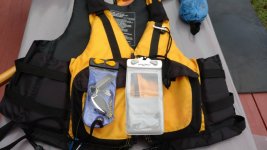I shattered the screen on my beloved Google Pixel 5a when I put it on top of my car and it slid off onto the pavement. I had no protective case on the phone at the time. So . . . it's time to shop for a new Google Pixel, likely one of the new model 9s announced in August 2024, for which I get big discounts as a Google Fi customer.
I've used my smart phones leashed to my PFD for photography, but have always used them in a waterproof case such as a Dry Pak:

I had never paid attention to the IP ratings of my phones, but I noticed that the Pixel model 9s have a rating of IP68, which is claimed to be protection against immersion in up to 3.5 meters of water for 30 minutes. That, if true, sounds as if the phone is waterproof enough for all but the most dire canoe situations such as rain and swims.
Has anyone used a naked IP67 or IP68 phone for canoe photography—i.e., without a waterproof case—leashed to the PFD? That could be done through the lanyard holes that are available on some phone cases. What's the argument against doing this?
I've used my smart phones leashed to my PFD for photography, but have always used them in a waterproof case such as a Dry Pak:

I had never paid attention to the IP ratings of my phones, but I noticed that the Pixel model 9s have a rating of IP68, which is claimed to be protection against immersion in up to 3.5 meters of water for 30 minutes. That, if true, sounds as if the phone is waterproof enough for all but the most dire canoe situations such as rain and swims.
Has anyone used a naked IP67 or IP68 phone for canoe photography—i.e., without a waterproof case—leashed to the PFD? That could be done through the lanyard holes that are available on some phone cases. What's the argument against doing this?
